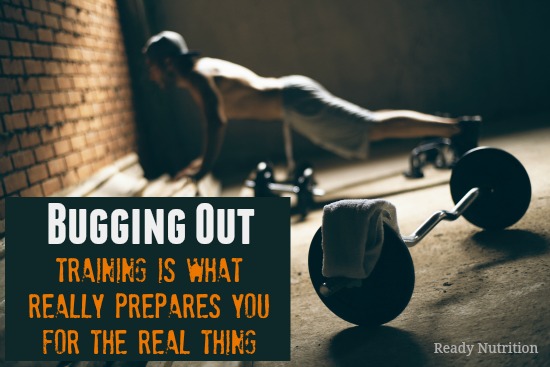Bugging Out: Training Is What Really Prepares You For the Real Thing

Getting Started
It costs nothing to wear your everyday clothes and go for a walk, which is exactly what you’ll most likely be doing if you need to bug out on foot if the SHTF. The best way to train for anything is to wear and use the clothes and equipment while training that you’d be wearing and using during the actual event. This allows you to become familiar with the way your equipment feels and to train for muscle memory.
” Muscle memory has been used synonymously with motor learning, which is a form of procedural memory that involves consolidating a specific motor task into memory through repetition. When a movement is repeated over time, a long-term muscle memory is created for that task, eventually allowing it to be performed without conscious effort. This process decreases the need for attention and creates maximum efficiency within the motor and memory systems. Examples of muscle memory are found in many everyday activities that become automatic and improve with practice, such as riding a bicycle, typing on a keyboard, typing in a PIN, playing a musical instrument, or martial arts.” (Source)
So, unless you plan on bugging out in gym clothes while riding a stationary bike, train exactly as you plan to bug out. For me, the ultimate goal was to be able to hike in rugged terrain while wearing a backpack.
Assess Your Fitness
Always know your baseline health before you start any fitness regimen. If possible (and applicable), get your cholesterol, blood pressure, oxygen saturation, and resting heart rate checked. These readings will allow you to determine where your overall health stands now and will give you a baseline to compare to as you improve. What you should NOT do is weigh yourself. Weight, in this context, has nothing to do with fitness and will only serve to distract you from your true goal. Remember, this isn’t about meeting some arbitrary standard of beauty- this is about becoming prepared to face physical challenges in the event of an emergency.
Next, determine where you are most likely going to be should you need to bug out and where you intend to go and then plot that course. Typically, your start point (Point A) is going to be the place you spend the majority of your week. Getting the baseline for your ability to go from point A to point B is simple- walk out the door wearing your everyday clothes, shoes, and nothing else. Go empty-handed and without your BOB. Note the time you start and walk as fast as you can (without breaking into a trot) for as long as you can, then note the time again. Make note of how far you’ve come. This is your Point B. Walk back at a leisurely pace, if you like. No need to hurry- after all, during a real bugout, you won’t likely be racing back to where you just came from.
The first time I did this I had to stop and sit down to catch my breath. I also chose a day that was fairly hot and I was very thirsty by the time I made it back home. Of course, one should never risk their life by attempting this in severe weather.
Building Up
Repeat the above every day until you can reach Point B without feeling taxed. You’ve just achieved muscle memory. Congratulations! You’ll also notice that you’re able to get to Point B much faster than your baseline time. If you’ve fallen short of reaching your bugout destination, it’s time to up the game. Do the same thing you did on your first day, but this time push yourself beyond Point B as fast as you can (again, without breaking into a trot) until you can’t go any farther. Make a note of how long it took you to get from Point A to Point C. If you still haven’t reached your bugout destination, continue repeating the pattern until you can without feeling taxed. Don’t get discouraged if you need to run through half (or more) of the alphabet before you can walk to your bugout destination empty-handed. It takes time to Build Up this kind of muscle memory and endurance.
If you find you’re able to get from Point A to your bugout destination on your very first try effortlessly, it’s time to gear up.
Gearing Up
Once you’ve been able to go from Point A to your bugout destination empty-handed as quickly as possible and with very little effort, it’s time to start adding gear. It’s best to keep your hands free (more on this later) and use the equipment you intend to bugout with. Consideration should also be given to your footwear. If you’re hoofing it, nothing beats a backpack. If need be, start light- this might mean just an empty backpack. If you’ve never worn one for more than a short period, you might be surprised at how sore your shoulders can become with very little weight. Adjust all your straps to get an appropriate fit. An excellent tutorial can be found here.
If you’re a woman, be sure to get a backpack designed for a woman. Our skeletal structure is different, especially across the shoulder area and we have boobs. A poorly fitted backpack has a much greater chance of either pinching us across the shoulder joints and under the armpits, or will be too large no matter how tightly adjusted. And there are no words to describe how uncomfortably painful an ill-fitting sternum strap can be, especially if it sits too low.
If you feel you can handle some weight, measure out some dried beans or rice and seal into Ziploc bags. I like to measure out both five- and ten-pound bagsful so that I can distribute the weight evenly inside the backpack and add or remove in increments. I use rice or beans for a variety of reasons: they’re inexpensive. If I find that I just can’t carry that load home because I pushed myself too far or developed a blister and need to lighten my load, I can dump the rice or beans out on the ground without stressing over the few cents they cost me. They’re also biodegradable and will either sprout or compost easily. The plastic bags weigh next to nothing and I can put it back in my pack.
Now is also a good time to add containers of water. Be sure to weigh your filled water containers. I like to carry a combination of both. The maximum combined weight of beans or rice and water shouldn’t exceed 20 pounds initially. More can be added later for most healthy, physically fit adults under the age of 70.
Start the process over again, this time with a backpack, using the same steps you followed in Building Up until you’re able to reach your bugout location as quickly and effortlessly as possible with the addition of the pack and weight. Keep increasing the weight in your pack until you’ve reached the maximum you can safely carry. Make a note of how much your max weight is- it will vary by person.
Dress Rehearsal
Once you’re able to go from Point A to your bugout location quickly and effortlessly while wearing your pack loaded with your bug out meals to the maximum weight you can carry, it’s time to take out the dried goods and fill your pack with your bug out gear. Weigh each item you intend to carry, including water and food. The total combined weight of gear, supplies, water, and food shouldn’t exceed the maximum weight you were able to carry before. Practice loading your pack and rearranging items as needed to get the best weight distribution for your gender and size. Build Up with a fully loaded pack containing your bugout gear.
Optional considerations: if you’re practicing in an area that would allow you to safely carry the weapon of your choice without getting arrested or scaring your neighbors, do so now. Families with babies or toddlers should consider practicing this trek while wearing a baby backpack appropriate for the age of your child and include older children to Build Up along with you. Likewise, those with dogs, especially dogs big enough to carry a pack, should include the dog from start to finish. Dogs need time to Build Up their strength and endurance, too.
No matter what kind of shape you think you’re in, training to bug out on foot and being prepared for the unique stresses it puts on your body is best accomplished practicing often with the actual gear and in the setting you’re most likely to find yourself when the SHTF. It builds strength, endurance, flexibility, and improves your cardio and respiratory fitness. And most importantly of all, you’ll be confident that you can stand – or run – on your own two feet.
Ruby is a first generation Californian who grew up in the heart of the Central San Joaquin Valley farming community. She’s been involved in agriculture for 40 years and learned to preserve food, traditional home arts, to hunt and fish, raise livestock and garden from her Ozark native mother.


